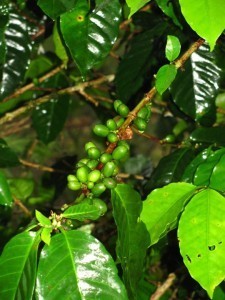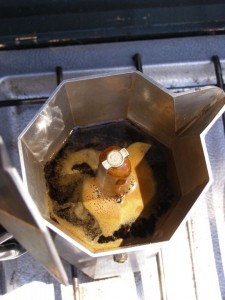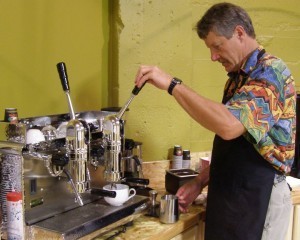I’ll be the first to admit I’m very picky about my coffee. I can tell when I walk into a coffee shop, by the sound of their steam efforts, if I’ll even bother trying what they are making. If I don’t like the sound of their milk, I may order an Americano. If there is no crema on the house espresso, I’ll look to a bold drip coffee or ask them to brew me a French Press of something interesting.
My first exposure to espresso drinks was when I moved to Boulder, Colorado around 1990. I frequented “The Trident” on Pearl Street where I’d order my Mocha and sit for some people watching. Within a few years, as I was carefully watching my budget and realizing how much COULD be spent on espresso drinks each month, I finally splurged and bought a home machine.
I spent less than $100 on a discount pump driven machine and set about learning how to use it. In addition to the information that came with the machine, I asked questions everywhere I went. In each coffee shop, I observed the barista carefully often asking them why they did what they were doing and asking if they had any tips for me at home. Thus began my training as a barista.
After that first machine burned out, I upgraded to a better one. Somewhere in the late 90’s, Starbucks offered a close out on their Estro Profi model which included a burr grinder. I swung back and forty debating whether or not to purchase such an outlandish splurge item. By the time I decided, the only machine left in the area was in Fort Collins.
That purchase was wonderful and mysterious. The machine originally sold for around $500 and was discounted. The machine they had left was a floor model so they gave me an additional discount. They also threw in pitcher, thermometer, Starbucks recipe book, a free pound of coffee and whatever else they could. Within months, I’d already saved more than the purchase price and was making lovely drinks at home.
In 2004, a friend was promoted to manager of the new Starbucks in Longmont, the first with a drive-thru. He asked me if I knew anyone who wanted a job and I noticed my hand going up. Seriously, all by itself! I told him I didn’t want a job, I already had my own business. However, I love coffee and I love people so if we could work out a very part-time schedule, I’d love the opportunity. I thought I’d learn a lot and stay over the summer. I stayed over 2 1/2 years!
About one year later, I saw a food program on TV about 7 years ago filmed at a food show exhibit in Las Vegas. They were filming “latte art” at one of the booths in the exhibit. That was the first experience of latte art for me and I was bitten hard. WOW! I knew I wanted to learn how to do that! So I started searching everywhere for tips on how to do that.
By this time, google and other search engines opened doors to all sorts of information. I started learning about the coffee world “outside” Starbucks, the specialty coffee industry. From written descriptions and video and forum tips, I worked very hard at learning how to pour latte art. What I discovered in the process was a very different and exciting way to steam milk that dramatically improved the taste and texture of milk.
I was asked to come to the Starbucks learning center in Denver and share what I was learning with Starbucks District Managers. They became excited about the taste difference between the kind of milk normally served and the kind of milk we could deliver. I had managers confide that they had stopped drinking milk based drinks at Starbucks because the quality was poor. The milk was burned tasting or too hot or the espresso didn’t carry through. For those who were committed, there was now a way, a reminder for many, of what was possible.
In Longmont, on my shifts, I almost always worked the drive-thru. I had two pitchers, made every drink fresh, knew how much milk and which pitcher to use for what drinks and kept up will all orders even during a rush. I know it’s possible. Tiring, nerve wracking, and rewarding, it is possible!
In the spring of 2005, I attended the “Fresh Cup Roadshow” in Tampa, Florida while visiting a good friend there. Many wonderful things popped out of that experience! I was able to go through a latte art class with Jerod Mockli who was the Executive Director of the Seattle Barista Academy at the time. I also met a great barista from Zoka Coffee who invited me to jump behind her machine, pull some shots and gave me more tips. Tracy Allen of Zoka Coffee gave a cupping class and I’ll always remember his inspiring us to “educate your palate, educate your palate, educate your palate” so we would be more aware of what we were drinking and what we liked. I went to SweetMarias.com for the coffee flavor wheel to help me educate my palate.
During that trip, I also met Terry Davis who was running Ambex Roasters at the time, the second largest coffee roasting manufacturer in the US. I sat at the bar in his coffee shop asking questions and learning more about coffee’s.
Starbucks approved my ideas and sent me to the American Barista and Coffee School in Portland for a latte art training with Matt Milletto. What an amazing experience that was being with other barista’s and having the opportunity to work with Matt. I was making great milk by that time but hadn’t perfected the pour.
In my research, I’d read a suggestion for practicing the latte art pour, “do it in a padded room so people can’t hear your screams of frustration”. I fully concur! I was so close but had little control over what I was doing. One moment, a beautiful pour would occur. The next 30 attempts left a formless white blob floating on top.
One thing I learned through this process: the latte art isn’t really the most important part. What is important is how a barista treats the milk.
I’ve had drinks with latte art that were horrible (burned, overheated, no sweetness left, little espresso flavor). I’ve also had lovely drinks with no art that were amazing…sweet, full of flavor, lovely mouth feel. The secret is really in how you treat the milk. I’ll write a post of the keys I’ve picked up in my search. For now, know that milk steamed only when it’s cold and then properly textured and not heated over 150° will have an amazing natural sweetness and the micro-bubbles that carry the flavor of the espresso. And it has such a nice “mouth feel” when done properly!
Through the generosity of others, tips from the hundreds of coffee shops I’ve visited, a ton of questions, hours of practice with gallons of milk and pounds of espresso beans, hours of research on the web and hours of video’s watched, I’ve distilled some milk frothing tips to help people get great velvety milk with tiny micro-bubbles.
As I’m finishing this, I’ve received a note from a friend visiting family in the Maryland and yearning for a “Larry’s Latte” as she’s been unable to find good coffee anywhere there. Once you’ve had great coffee, it’s tough to settle for less.


